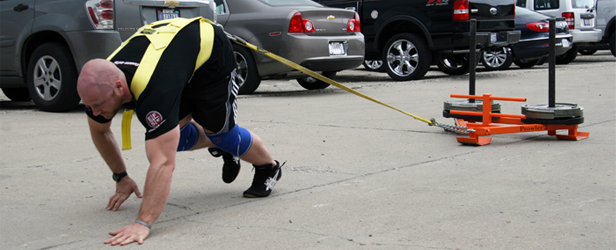
Previously I discussed how adding in various training tools can “fill in the holes” of standard barbell lifting. Kettlebells have gained a stronger and stronger following in the strength training community, but sleds and sandbags are two tools that have yet to gain their recognition.
Infomercial? I think not. These two tools are at the heart of Elite training programs but have still been ignored by a large section of the fitness and sports performance community because they are viewed as “hardcore” or dangerous. In fact, sandbags and sleds can be two of the mort versatile training implements. They allow for one to develop great levels of anaerobic endurance, muscular endurance, speed, and power. In addition, sled and sandbags are relatively easy to implement and have a wide crossover to many populations.
Sleds saw their first rise of popularity in the track community to assist in speed development. Sprinters used them for speed-strength work on the track. This was a very specific method for training strength that would carryover to speed on the track. However, not to be a detriment to their sprinting, there was great interest in finding the optimal amount of weight to use that would not alter sprinting mechanics. The sled still remains a very helpful tool for sprinters.
Westside Barbell began to popularize sled training for another group of athletes—strength athletes. The powerlifting community began to see the value in sled training in promoting recovery and building specific conditioning that would allow them to tolerate greater training intensities. Strength athletes could again train their hips in a very specific and functional manner. They worked the lower body in ways that the body was meant to move. Upper body drills are performed in the same manner, and most importantly, without eccentric muscle actions. This is very helpful when rehabbing injuries and preventing excessive fatigue.
With coaches like those at Westside Barbell helping the exposure of sleds, other strength coaches began to see increased versatility of sled training for athletes and general fitness clients alike. The ability to train a wide array of movement patterns by simple means allows coaches to increase their ability to help clients recover from injury, improve anaerobic endurance, improve recovery, and train stabilizer muscle groups in functional positions.
Legendary author of Dinosaur Training, Brooks Kubik states, “You feel sore as you do because the bags (sandbags) worked your body in ways you could not approach with a barbell alone. You got into the muscle areas you normally don’t work. You worked the “heck” out of the stabilizers” (Kubik B (2006) Dinosaur Training, pgs 115). Stabilizer training is nothing new. In fact, the three implements we have discussed—kettlebells, sleds, and sandbags—qualify very well for stabilizer strength enhancement. This is especially true in light of the recent “functional” training movement that missed the boat a bit in the goal of improving the quality of strength and movement by enhancing the strength and functionality of the stabilizers. The “functional” training gurus tried to improve stabilizer strength by training people on unstable objects. While this may be beneficial in very isolated cases, the body was not challenged in more complex movement patterns or loads.
Unlike many other more recent theories of performance enhancement, sandbags have a long history of being very effective for athletes. Sandbags have long been a favorite training tool of wrestlers and combative athletes alike. In John Jesse’s famous book, Wrestling Physical Conditioning Encyclopedia, he states, “The use of heavy sandbags and their large circumference forces the lifter to do his lifting with a round back instead of the traditional straight back lifting with a barbell. It is this type of lifting that truly develops a strong back. It develops the back and side muscles in movements that are identical to the lifting and pulling movements of wrestling.”
While some may cringe at the idea of round back lifting, it is a necessary training method for most individuals. Such movements represent the idea of “imperfection training.” Not training in these specific ranges of motion is the reason why many can be injured when they actually are challenged (either in daily life or sport) in these patterns. Again, this is why sandbags really “fill in the holes” of standard barbell training very well.
This has already been used by strength coaches like Allen Hedrick, the head strength coach at the Air Force Academy. He has written and lectured on the idea of using odd objects—often in the form of water filled kegs—to increase performance and decrease the risk of athletic injuries. “But applying the concept of specificity, it makes sense that training with a fluid resistance is a more sport-specific method of training as compared to lifting exclusively with a static resistance because in most situations, athletes encounter a dynamic resistance (in the form of an opponent) as compared to the static resistance. Further, because the active fluid resistance enhances the need for stability and control, this type of training may reduce the opportunity for injury because of improved joint stability” (NSCA Journal, Volume 25, Number 4).
While Coach Hedrick was referring to keg training, sandbags can offer the same benefit. Sandbags alter their shape and flow from repetition to repetition, again increasing the demands placed on the stabilizers. This form of training should not be overlooked as a progressive method in conjunction with barbell training. In Part III of this series, we will look at some of the most productive drills and means in incorporating these training tools.
Elite Fitness Systems strives to be a recognized leader in the strength training industry by providing the highest quality strength training products and services while providing the highest level of customer service in the industry. For the best training equipment, information, and accessories, visit us at www.EliteFTS.com.








